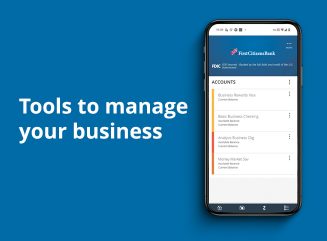Digital banking for business
Seamlessly access all of your accounts from one place with First Citizens Digital Banking for business.

Control your portfolio
Invest how you want, when you want, in real time with Self-Directed Investing.

Digital banking for business
Seamlessly access all of your accounts from one place with First Citizens Digital Banking for business.
See how we're supporting companies
We're committed to serving companies as they expand and succeed. The proof is in our success stories.
Q4 Quarterly Market Review: Available now
The Making Sense team reviews changes in the market during Q4 2025.

Michelle Chan-Ponder
Area Executive
Manufacturers need cash to generate revenue. Without it, they might be hard-pressed to attract customers, purchase raw materials, procure equipment and supplies, or pay workers and consultants. Cash flow management in manufacturing can impact key performance indicators and make or break success.

A healthy business generates positive net cash flow from operating activities. Ideally, this flow increases over time. However, even businesses with growing sales and revenue can run into a cash flow problem due to an inability to address external or internal factors.
When a business fails to consistently generate positive net cash from operating activities, it may need to rely too heavily on the availability of credit (or other external financing sources) to operate. Healthy cash flow can position a company to take advantage of opportunities for growth, avoid excessive borrowing, reward shareholders and better survive turmoil in the market and economy.
Business leaders typically understand the fundamental importance of cash flow management, especially how it can be impacted by external factors such as the economy, the dynamics of the financial markets, unreliable customer demand forecasts and various industry-specific issues.
However, there are also critical factors under management's control that can transform the company's cash flow. While specific solutions can vary across industries and sectors, these key areas can yield solutions for improved cash flow management in manufacturing.
The operations section of the cash flow statement can reveal the strong relationship between cash flow and various financial functions of the business, such as accounts receivable and accounts payable. Scrutinizing all operational processes can uncover ways to improve financial ratios and internal financial benchmarks. Tight production planning and control may prove to be an integral part of cash flow management strategy.
Seek to minimize production and process waste. Aim also to identify specific ways to deal promptly with inefficiencies—across all processes involving materials and labor—as they might arise. For example, improvements in supply forecasting and fulfillment with vendors, as well as customers, can provide tangible results for the bottom line.
Consider optimizing inventories with the goal of shrinking the turnover cycle to 30 days or less, if possible. Don't overlook work in progress as a potential source of inefficiency. Are inputs made available as per schedule to avoid bottlenecks and rush orders?
Healthy cash flow can also be tied to savvy investment and financing activities. A healthy business may more often show negative net cash flow from financing activities, especially if cash flow from operating activities is used to pay dividends or pay off external financing. Use company lines of credit wisely to ensure quality equipment and plant infrastructure is available when needed.
A successful journey towards better cash flow can start with robust data analytics and reporting. Operational data, along with other information from the business and its external partners, can guide a working capital optimization plan that tackles cash flow management challenges from various points.
Getting customers and doing the work is often not the biggest challenge to cash flow. The key is getting paid promptly for the goods produced. Specialized software may aid in collecting money owed to the company faster and more accurately, and it may help better manage spending. Software-driven data solutions can drive efficiencies in a variety of specific ways, including:
Think about implementing purchasing cards to help with controls around procurement spend throughout the sales cycle. Tools like this can help you efficiently implement a smart, strategic approach to cash flow management, so you can make your business more predictable and profitable.



This material is for informational purposes only and is not intended to be an offer, specific investment strategy, recommendation or solicitation to purchase or sell any security or insurance product, and should not be construed as legal, tax or accounting advice. Please consult with your legal or tax advisor regarding the particular facts and circumstances of your situation prior to making any financial decision. While we believe that the information presented is from reliable sources, we do not represent, warrant or guarantee that it is accurate or complete.
Third parties mentioned are not affiliated with First-Citizens Bank & Trust Company.
Links to third-party websites may have a privacy policy different from First Citizens Bank and may provide less security than this website. First Citizens Bank and its affiliates are not responsible for the products, services and content on any third-party website.

Treasury & Cash Management
Electronic Bill Presentment & Payment
Investment & Retirement Services
Community Association Banking
Equipment Financing & Leasing
Credit Cards
Merchant Services
Email Us
Please select the option that best matches your needs.
Customers with account-related questions who aren't enrolled in Digital Banking or who would prefer to talk with someone can call us directly.